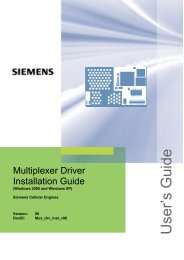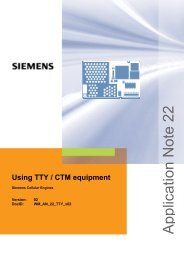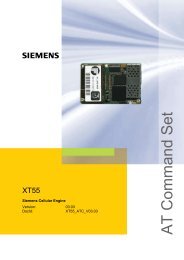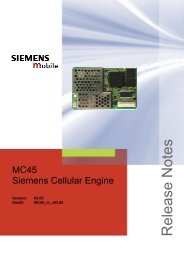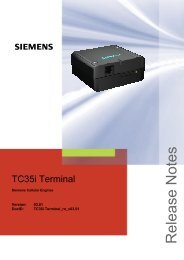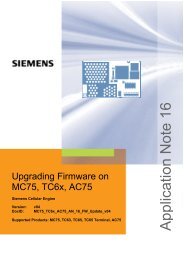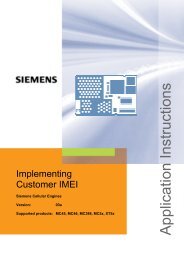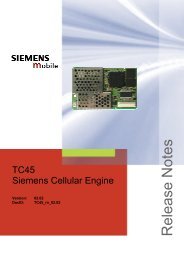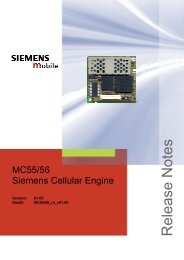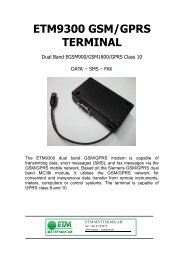Hardware Interface Description - Wireless Data Modules
Hardware Interface Description - Wireless Data Modules
Hardware Interface Description - Wireless Data Modules
Create successful ePaper yourself
Turn your PDF publications into a flip-book with our unique Google optimized e-Paper software.
MC55/56 <strong>Hardware</strong> <strong>Interface</strong> <strong>Description</strong><br />
Confidential / Released<br />
s<br />
3.9.1 Features supported on first and second serial interface<br />
ASC0<br />
• 8-wire serial interface<br />
• Includes the data lines /TXD0 and /RXD0, the status lines /RTS0 and /CTS0 and, in<br />
addition, the modem control lines /DTR0, /DSR0, /DCD0 and /RING0.<br />
• It is primarily designed for voice calls, CSD calls, fax calls and GPRS services and for<br />
controlling the GSM engine with AT commands. Full Multiplex capability allows the<br />
interface to be partitioned into three virtual channels, yet with CSD and fax services only<br />
available on the first logical channel. Please note that when the ASC0 interface runs in<br />
Multiplex mode, ASC1 cannot be used. For more detailed characteristics see [11].<br />
• The /DTR0 signal will only be polled once per second from the internal firmware of<br />
MC55/56.<br />
• The /RING0 signal serves to indicate incoming calls and other types of URCs (Unsolicited<br />
Result Code). It can also be used to send pulses to the host application, for example to<br />
wake up the application from power saving state. For further details see Chapter<br />
3.12.2.3.<br />
• Autobauding is only selectable on ASC0 and supports the following bit rates: 1200, 2400,<br />
4800, 9600, 19200, 38400, 57600, 115200, 230400 bps.<br />
• Autobauding is not compatible with multiplex mode, see [11].<br />
ASC1<br />
• 4-wire serial interface<br />
• Includes only the data lines /TXD1 and /RXD1 plus /RTS1 and /CTS1 for hardware<br />
handshake. This interface is intended for voice calls, GPRS services and for controlling<br />
the GSM engine with AT commands. It is not suited for CSD calls, fax calls and Multiplex<br />
mode.<br />
• On ASC1 no RING line is available. The indication of URCs on the second interface<br />
depends on the settings made with the AT^SCFG command. For details refer to [1].<br />
ASC0 and ASC1<br />
• Both interfaces are configured for 8 data bits, no parity and 1 stop bit, and can be<br />
operated at bit rates from 300bps to 230400 bps.<br />
• XON/XOFF software flow control can be used on both interfaces (except if power saving<br />
is active).<br />
Table 13: DCE-DTE wiring of 1 st serial interface<br />
V.24<br />
circuit<br />
DCE<br />
DTE<br />
Pin function Signal direction Pin function Signal direction<br />
103 /TXD0 Input /TXD Output<br />
104 /RXD0 Output /RXD Input<br />
105 /RTS0 Input /RTS Output<br />
106 /CTS0 Output /CTS Input<br />
108/2 /DTR0 Input /DTR Output<br />
107 /DSR0 Output /DSR Input<br />
109 /DCD0 Output /DCD Input<br />
125 /RING0 Output /RING Input<br />
MC55/56_hd_v02.06 Page 52 of 105 29.10.2004



